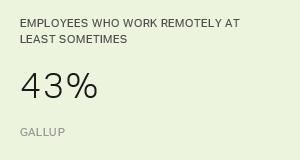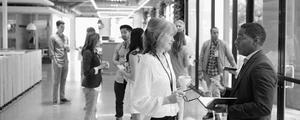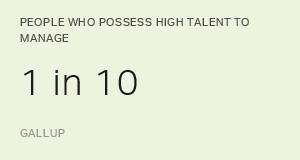This is the fourth article in a four-part series about engaging a remote workforce. Catch up on the first, second and third articles in the series.
When Gallup studied the effect that leaders can have throughout an organization, the most powerful question we asked employees was whether their company's leadership made them "feel enthusiastic about the future." Sixty-nine percent of employees who strongly agreed with this statement were engaged in their jobs, compared with a mere 1% of employees who disagreed or strongly disagreed.
That research into leadership uncovered four needs of followers, and Gallup categorized those needs by the words people used for them: trust, compassion, stability and hope. The first three articles in this series examined trust, compassion and stability related to remote workers' engagement and performance. In this article, we will discuss hope's influence on engagement and performance and explore how managers can convey a sense of enthusiasm about the future with their remote workers.
First, let's define "hope" -- or what makes people feel enthusiastic about the future. The late Dr. Shane Lopez, a Gallup senior scientist, spent his career studying hope. He defined "hope" as "the belief that the future will be better than the present, along with the belief that you have the power to make it so." Instilling hope is an obvious requirement of those who lead other people, not because it's easy, but because it's incredibly important to followers.
Building a sense of hope for remote employees is essential to their engagement and profoundly affects their performance. While job descriptions rarely mention it, every job is fraught with complexity, change and competing objectives. With 43% of employees working away from their team members at least some of the time, figuring out what to do, think or feel in the midst of daily chaos can lead to frustration and eventually disengagement. Hope provides lift, drawing remote employees out of present impossibilities into a future filled with possibilities.
Meredith manages a team of remote healthcare workers for a nongovernmental organization. Her team's level of engagement has a direct effect on human lives, but they work under the worst conditions and in the roughest places imaginable. It might seem impossible to instill a sense of hope in a situation like that, but Meredith considers hopefulness part of her job. "Hope is everything. My people need to know that we see a better future for their patients and that they can provide it. Without hope, they disengage, they can't perform and they and their patients will suffer for it. It's that simple."
Most managers don't have the constant pressure Meredith does, but all must give their employees hope no matter the distance. To create hope for your remote employees:
- Encourage their development (Q06). Development typically focuses on the future. Development says to the employee, "I believe in you. You add value to our team. I see you as an integral part of our team and our organization's future." One of the best ways to create hope is to help your remote employees learn and grow in areas that matter to them and benefit the team and organization.
- Talk often about the organization's mission and discuss how each employee contributes to it (Q08). Most organizations have an aspirational and inspirational mission or purpose. What is your organization doing? How does each remote employee contribute to your organization's mission or purpose? Remote workers spend more time away from their manager and coworkers. Yet, they still want to feel like they are part of something bigger than themselves. When you help remote employees see how they affect the organization's local, regional or national mission, you fill your remote workers with hope.
- Make a commitment to quality the foremost thing (Q09). When employees are scattered across the city, region or even the world, they can't physically rally together to make something happen. Quality work requires all employees -- wherever they are located -- to make a quality contribution. Where there is no shared commitment to quality, there is no hope. Have conversations about quality with remote employees, inviting them to be open about things they believe interfere with it.
- Help them find a best friend at work (Q10). Friends at work become best friends because they provide what we need most: a listening ear, advice in the midst of chaos and hope in the midst of despair. Helping remote workers find a best friend at work will take creativity and depends on how your workforce is dispersed and what options exist for connecting team members. Finding ways for your remote workers to connect and find at least one best friend at work is essential to their engagement and performance. Remember, remote employees don't want to feel isolated.
The guidance, direction, support and encouragement you provide to each remote employee are the facets of hope. Hope is essential to human existence and peak performance. Remote workers must believe that the future will be better than the present and that they have the power to make it so. That belief nurtures engagement, which benefits your relationships with your people.
Ask yourself the following five questions each week to enhance your capabilities as a manager who creates hope for your remote employees:
- Who are the most hopeful leaders in our organization? What am I doing to ensure that I hear and convey what they are saying to my remote workers?
- What have I heard that makes me feel hopeful this week? When will I share this information with my remote employees?
- How am I helping remote employees see how they connect and contribute to where we are going as a team and an organization?
- How can I create opportunities for remote workers to share hope with one another?
- How can I make hope a part of a conversation about bad news?
If, as a manager, you are not creating hope and helping people see the way forward, chances are, no one else is either. If peak performance of all employees is your objective, show them what the future looks like, assure them you'll get there together and help them get there.
If you've read all four articles in this series, you may have noticed a common thread: the most effective manager/remote worker relationships have an emotional component. Building trust, showing compassion, providing stability and creating hope aren't rational, transactional activities like checking work reports. They're relationship activities. They're personal and individual. And they are essential.
Employee engagement depends on an emotional bond that personal interactions between managers and workers create. When people feel emotionally attached to their boss and company, they work better. They bring their strengths to the job. They are more productive, they feel comfortable offering good ideas, they're more willing to help their colleagues and they make their companies more successful every day.
Creating that emotional component is slightly harder for managers of remote workers. These managers have to be intentional about demonstrating trustworthiness and compassion. They have to make an effort to instill hope and security. Managers who see their people every day have the luxury of unplanned opportunities to create an emotional bond. Managers of remote workers don't have these opportunities.
But not seeing your employees in person every day means that forging an emotional bond with them will always be at the forefront of your mind in your every interaction with them.
Decades of Gallup research shows creating an emotional bond with employees is worth the effort. Managers who create trust, compassion, security and hope engage workers. Engaged workers are productive workers. Managers of remote employees can get the performance they need from their remote workers -- it just takes a bit more planning and effort.
Did you miss the other articles in this series? Start from the beginning.
Learn more about how Gallup can help you engage remote employees:
- Download our State of the American Workplace report to get further insights into the performance needs of remote employees.
- Listen to our Managing Your Remote Workers webinar to hear what our experts have to say about the importance of communication in engaging remote employees.
- Inquire about our employee engagement solutions to find out how you can create a culture of engagement.
- Register for the Leading High-Performance Teams course to get the tools and techniques you need to develop and engage all employees, regardless of where they work.


